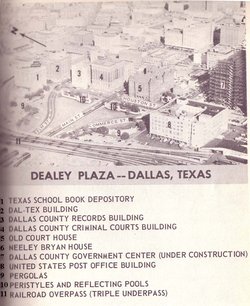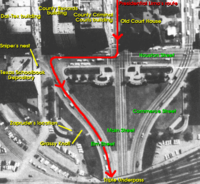Dealey Plaza
|
|
Dealey Plaza, (pronounced deal-ee) in Dallas, Texas, United States, is famous as the location of the John F. Kennedy assassination on November 22, 1963.
| Contents |
History
Dealey Plaza is a park completed in 1939 on the west edge of downtown Dallas where three streets converge (Main Street, Elm Street, and Commerce Street) to pass under a railroad bridge. The plaza is named for George Bannerman Dealey 1859–1946), publisher of the Dallas Morning News and the man who had campaigned for the area's revitalization. Many believe the monuments outlining the plaza are there to honor President John F. Kennedy, but they actually honor previous prominent Dallas residents, and predate President Kennedy's visit by many years. The actual Dallas monument to Kennedy, in the form of a cenotaph, is located several blocks away.
Kennedy assassination
Dealey Plaza is bounded on the south, east, and north sides by 100'+ tall buildings. One of those buildings is the Texas School Book Depository building, from where the Warren Commission concluded that Lee Harvey Oswald, acting alone, fired a rifle that killed the president. There is also a grassy knoll, from where the House Select Committee on Assassinations controversially concluded that a second gunman also fired at (but missed) President Kennedy. At the plaza's west perimeter is a triple overpass railroad bridge, under which the motorcade raced after the shots were fired.
Today the plaza is typically filled with tourists visiting the assassination site and the Sixth Floor Museum that now occupies the top two floors of the seven storey School Book Depository. Since 1989, some 4-million-plus people have visited Dealey Plaza.
One of the better-scaled maps of Dealey Plaza showing witnesses' locations and observations, suspected assassins' locations, evidentiary artifacts, and other valuable information can be found here (http://members.aol.com/droberdeau/JFK/DP.jpg).
After the assassination, city leaders decreed that Dealey Plaza and the surrounding buildings would be maintained in their 1963 condition to preserve the area in honor of the fallen president. The United States government has declared Dealey Plaza a national, protected historical landmark. Therefore, nothing has been torn down or rebuilt in the immediate area. (A small plaque commemorating the assassination exists in the plaza.)
Visitors to Dealey Plaza today will see street lights and street signs that were in use in 1963, though some have been moved to different locations and others removed entirely. Buildings immediately surrounding the plaza have not been changed since 1963, presenting a stark contrast to the ultra-modern Dallas skyline that rises around it.
Over the last 40+ years, Elm Street has been built up by resurfacing; street lanes' stripes have been relocated; sidewalk lamp posts have been moved and added; trees, bushes and hedges have grown; and some traffic sign locations have been changed, relocated or removed. In late 2003, the city of Dallas approved construction project plans to restore Dealey Plaza to its exact appearance on November 22, 1963. As of early 2004, the funds to do so had been approved.
The "grassy knoll"
The "grassy knoll" of Dealey Plaza is a small, sloping hill inside the plaza that became infamous following the John F. Kennedy assassination. The knoll was above President Kennedy and to his right (west and north) during the assassination on November 22, 1963.
The north grassy knoll is bounded by the Texas School Book Depository building along the Elm Street Abutment side street to the northeast, Elm Street and a sidewalk to the south, a parking lot to the northwest, and a railroad bridge above the triple underpass convergence of Commerce, Main, and Elm streets to the west.
Located within the north grassy knoll on November 22, 1963, were dozens of witnesses; three large traffic signposts; four sidewalk lamp posts; the Bryan's north pergola cement structure, including its two enclosed shelters; a tool shed; one 3.3' high cement walls connected to each of the pergola shelters; ten tall, wide, low-hanging live oak trees; a 5' tall, wooden, picketed, cornered, stockade fencelines approximately 176' long; six street curb sewers openings, their sewers manholes, and their interconnecting large pipes; and numerous 2' to 6' tall bushes, trees, and hedges.
Some assassination theories have concluded that a shot or shots came from the north grassy knoll during the assassination. The House Select Committee on Assassinations investigation from 1975 to 1979 concluded that an unknown assassin fired the third of four shots fired at President Kennedy from behind the picket fence on the grassy knoll and that "there was a probable conspiracy in the assassination of President Kennedy." This conclusion was based on a single piece of evidence: a Dictabelt recording of a stuck radio microphone on a police motorcycle that captured sounds thought to be the gunshots of the assassination. After the committee finished its work, crosstalk from another radio channel of transmissions known to have been made a minute after the assassination was found on the dictabelt, proving that the sounds on the recording could not be the gunshots of the assassination.
Because of persistent debate, answered and unanswered questions, and conspiracy theories surrounding the Kennedy assassination and the possible related role of the grassy knoll, the term "grassy knoll" has come to also be a modern slang expression indicating something may be suspicious or something that suggests that there are untold aspects.
External links
- Texas Twisted: JFK Assassination Tour with color photos of Dealey Plaza (http://www.texastwisted.com/attr/jfk/03/)
- Dealey Plaza Cam - a view from the sixth floor window (http://www.earthcam.com/jfk/)
- Dr. Thomas study of the grassy knoll shot, March 2001 (http://www.forensic-science-society.org.uk/Thomas.pdf)
- Dr. Thomas study of the grassy knoll shot, November 2001 (http://pages.prodigy.net/whiskey99/hearnoevil.htm)
- Dr. Thomas study of the grassy knoll shot, September 2002 (http://pages.prodigy.net/whiskey99/emendations.htm)
- Dr. Thomas study of the grassy knoll shot, November 2002 (http://www.geocities.com/whiskey99a/dbt2002.html)
- Dr. Thomas study of the grassy knoll shot, December 2003; Court-tv rebuttal (http://pages.prodigy.net/whiskey99/courttv.htm)
- Evidence of a Head Shot From The Grassy Knoll (http://www.boston.quik.com/amarsh/headshot.txt)
- The Man Who Named the Grassy Knoll (http://mcadams.posc.mu.edu/gk_name.htm) - by Gary Mack of Sixth Floor Museum (http://www.jfk.org/)
References
- Template:Book reference (pp. 238-242, unraveling of acoustic evidence in JFK conspiracy finding)


